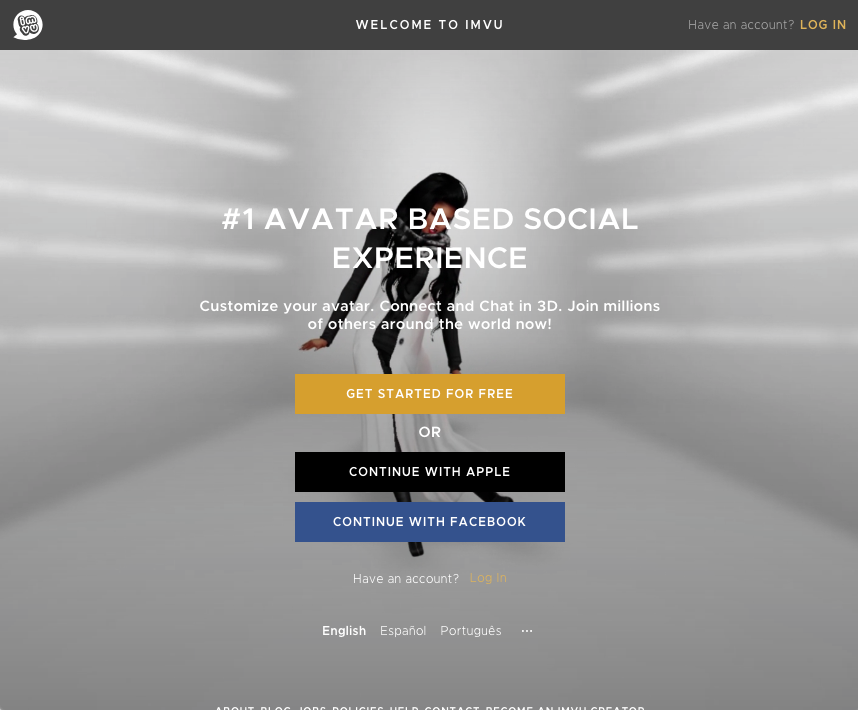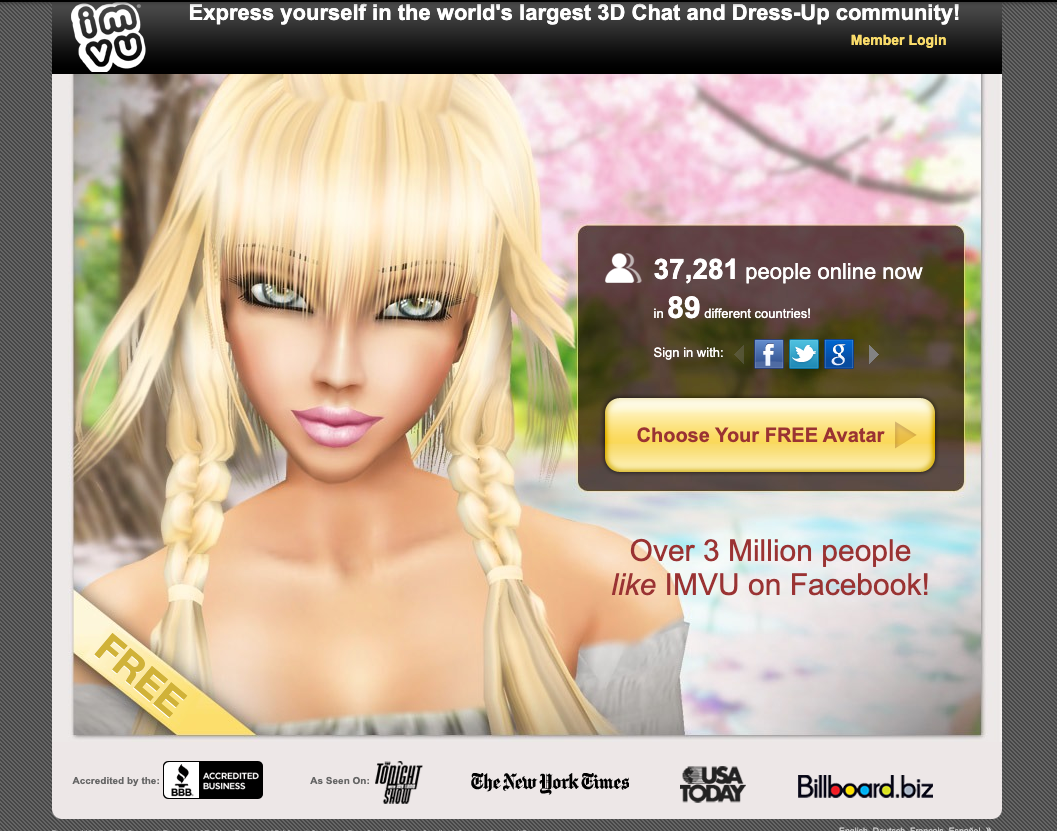When I started at IMVU as their head of marketing, it was like starting with a blank sheet of paper. With a bare-bones Web site that had been built and remained fairly unchanged since 2004. The focus was on driving people to the Desktop application. IMVU was like a secret underground night-club that seemed to oversell its social capacity.
I started by developing a Brand Foundation for IMVU - principles, messaging, goals, and vision. Essentially, defining how to present our brand and product as well as how to speak to existing and new subscribers. From there, I led the Creative design for a visual and verbal language for the brand.


The new Web site was a way to tease prospective users, using a familiar visual language, but coupled with a fantastic set of visuals that were created within IMVU for an authentic picture of the app experience.
I created information-graphics that focused on key metrics that I knew would be compelling to consumers and creators. Some of these graphics were used to promote the Creator Program, that was a "high-bar" group of users that made 3D clothing, objects, and environments that consumers purchased. This was an area I felt was greatly under-promoted. I knew winning over this group and growing it, establishing a community would be key to growing the overall MAU.
As part of my strategy for growing the platform and focusing on Creators, another product I drove was the creation of an ad-platform for Creators to promote their products. These "content ads" would look like organic social media posts in the avatar-based social "Feed" but would drive users to the Creators' products in the store. I created a simple landing page that explained the program in simple terms, similar to my ad-products design experience at Mode Media.
The landing page was compelling and simple. It showed examples of the ad-products as well as the metrics and dashboards that come along with the program. In the first year, we established a brand new $500k revenue stream for the company. By the time I left, it was generating more than double that.
We were gaining traction with generating additional traffic with User-Acquisition program I put into motion, and I felt we needed to generate more compelling imagery to use in both on-service and off-service marketing. We began developing an influencer program by reaching out to existing users that had a particular mastery of the product and high visual skills for creating avatars. We developed relationships with those users and were able to compensate them using the platform's existing "Credit" currency instead of fiat-cash. We enlisted users to help us curate the Feed as well as creating awesome graphics for our marketing.
We quickly developed a mutually-beneficial influencer program that helped the team learn about users and showcase incredible examples of creativity, personality, and visual craft. It was at this time that we started getting contacts from music celebrities to use avatars for music videos as well as MTV to be featured in some of their shows.
As I continued to learn about the nuances in the user-experience, paired with what actual users were seeking in their daily use of IMVU, I found other areas of marketing and the Product to shore up. I also needed to champion an understanding within the company - as so many people building the product didn't actually use IMVU. We supported both internal and external programs for "events" that users and employees could participate in. There was already a very reliable daily seasonal set of events that occurred in the Product whereby users would "dress up" and take photos of themselves and showcase those photos in the Feed as a sort of "runway show." My team would award individual users with prizes for the best-dressed, etc.
IMVU is essentially "virtual" social media - where users can visit rooms, meet and converse with other avatars, and even develop avatar-based relationships (real or make-believe); and show it all off in the social Feed for everyone to see. There were real-life (and made up) "soap operas" in play all the time.
With more than 60% of the usage coming for "rest of the world" my team also worked to diversify our Web presence to include language-specific content in order to drive more engagement.
We iterated on our AppStore graphics and messaging to optimize for downloads of our mobile app.
In 2018 we achieved several editorial features in the Apple Mobile App Store, including "Apps we love" for Social - a category I was pushing hard to be recognized in, instead of a pure games category.
While the company had a Customer Help site since the product launched in 2004, it had been fairly static and the design didn't align with the new Marketing work. We developed a new design that essentially "Skinned" this Salesforce platform and connected with the Product more.
I recognized that we had the best content creators right in front of us, as our users. In turn, these users just wanted the spotlight for a moment, so I created the VU Model program. These ultimately provided us with a totally free stream of amazing creative content at no cost.
Our team further created programs on Twitch and YouTube that featured demos and "travel logs" to get to know the best rooms to visit in IMVU. Our internal Marketing team did the voiceovers and recorded videos all within IMVU on a weekly basis for an incredible pipeline of content for users to consume. The combination of user-acquisition content from our creators and influencers, as well as these programs drove massive increases in our YouTube and social channels.
Furthering our commitment to Creators, I recommended having a presence at the Game Developers' Conference (GDC) where we would demo the new IMVU Creator platform and just generally introduce the overall IMVU Platform to 3D artists and creators. This was a booth design we created along with several of the collateral pieces you've just seen previously - as well as following that specifically explains the Creator program. Resulting form the first GDC conference, we increased our overall Creator program by more than +10% and it continued to grow dramatically.
The IMVU Creator Program collateral was a complex promotional package that explained many of the nuances of the platform, Creator Tool and overall platform.
Some graphic illustrations I sketched out that helps convey the complex ecosystem that Creators can participate in along with the types of different Creator opportunities.
One of the most successful programs I drove was the outreach to some of the outstanding visual designers/creators building 3D objects and selling those objects on IMVU. These Creators were both inspiring to other users for their creativity and craft as well as just wonderful sources of content creation that we could work with for very low cost. We enlisted some Creators to make content, others to create teaching-video tutorials and more.
I challenged the team to build a simple "Getting Started" on-boarding flow for new users through a simple Web landing page design, and we created this example. Dress up, make friends, and then visit and room and post photos (on the Feed). A very simple recipe for getting started. This program and others were instrumental in driving both new subscribers as well as our monthly active users.
Of course all of the landing pages were all connected to social content being tested daily in our user-acquisition program. Ultimately the highest performant content was used to drive specific interest for Creators vs. Consumer users through highly tested content. Again, all content was created by our creator users.
As we ultimately launched LIVE Events and Rooms on the platform, we created additional resources for users to refer to (and our social content programs as well) that could highlight opportunities for engagement. These Web programs were intended to be testing grounds for prospective product features, ultimately. Once the Live Events page proved itself as a major traffic driver, that feature was added to the Product Roadmap.
The featured rooms became a huge draw as the product experience didn't really offer a way to truly editorialize on the user-experience for some of the most robust rooms. This new template provided a sort of "Travel Guide to IMVU" for better understanding the scenarios for use in each of the rooms.
As the Creator program grew, I encouraged the team to come up with events and programs to entice Creators for participation. While there was already weekly events they could participate in, I always envisioned special limited edition gifts for our creators. The above card deck was an idea I had to let Creators bid on a particular card that they could feature their avatar in.
The project was meant to entice some of the most active and "wealthy" creators to spend some of their saved up credits, since there were only 52 options for sponsorship. At some of the highest pricing of any contest, we managed to sell out the sponsorship options in less than 24 hours. We produced the deck with each supplied Avatar, and then both distributed the decks to the Creators who sponsored as well as made the deck something all users could purchase for a limited time.
When the program was complete, we'd managed to "remove" over 30M credits from circulation.
At the 15 year anniversary for IMVU, there was renewed controversy with not just IMVU by all Avatar-based products, like Roblox and more. The controversy stemmed from problems on other platforms with trolling and preditorial actions by some members on younger subscribers. I took the opportunity to create messaging to address the concern and ultimately a print-piece that we distributed physically and digitally, to double-down on IMVU's commitment to protecting users.
The opportunity to reaffirm the company's mission to connect people together in a safe and fun environment was a simple message to convey, but in a time of challenges with diversity and equality, the messaging had to be clear and concise. The content of the brochure was used in our social campaigns as well as within the IMVU ecosystem through our Creator Ad program as well. I believe firmly that the "doubling-down" to reaffirm this messaging was an investment in the company and platform's future.